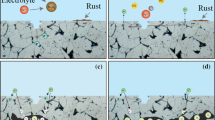Abstract
The operational reliability of feed pipelines made of 15GS steel used at thermal power plants is considered. The reason for the study consists in an incident at a Mongolian TPP, constructed according to a Soviet project, consisting in the detection of cracks in one of the bends of the feed pipeline. The zone of metal damage was removed, after which three fragments of the bend were sent for investigation to the All-Russia Thermal Engineering Institute (JSC VTI). After a nondestructive testing of the bend under laboratory conditions demonstrated the absence of defects in the metal and, thereby, indicated the locality of damage, the metal of the bend was examined in samples. The studies on the chemical composition and microstructure of the bend metal have confirmed its overall compliance with engineering specifications in these characteristics. According to the results of mechanical tests, the strength and plastic properties of the bend metal also met the requirements of engineering specifications. Furthermore, the metal of the stretched zone of the central part of the bend, wherein damage was detected, has exhibited a higher level of strength characteristics and a lower plasticity compared to other sections of the bend. In addition, the metal of this zone exhibited a lower impact strength and an increased value of the ratio between yield strength and tensile strength, which indicates brittle conditions. This has been confirmed by the determination of the critical brittleness temperature, whose value for the metal of the stretched zone of the central bend fragment is rather high amounting to at least 90°С. The results of strength calculations have confirmed compliance with the standard strength conditions for pipeline bends and, at the same time, they have demonstrated a very high level of local tensile stresses on the outer surface of the stretched bend zone. The calculation of the tendency of bends for the brittle fracture has shown that, taking into account the dimensions of surface’s technological defects allowed by the engineering specifications, the boundary of the brittle fracture of the bend is significantly lower than the pipeline operation temperature, but the hydraulic testing of the pipeline should be carried out at a temperature not lower than 60°C according to the conditions of brittle strength.




Similar content being viewed by others
REFERENCES
E. A. Grin’, “Operational reliability and longevity of the feed pipelines of power units at thermal power stations,” Therm. Eng. 63, 648–654 (2006).
TU 14-3R-55-2001. Seamless Steel Pipes for Steam Boilers and Pipelines: Technical Conditions (Tsentr. Nauchno-Issled. Inst. Tekhnol. Mashinostr., Moscow, 2001) [in Russian].
A. P. Bobrinskii, V. Yu. Gol’tsev, E. A. Grin’, V. A. Sarkisyan, and I. O. Kravchenko, “The crack resistance of 15GS pipe steel,” Therm. Eng. 43, 969–972 (1996).
RD 10-577-03. Typical Instructions for Metal Control and Extending the Life of the Main Elements of Boilers, Turbines and Pipelines of Thermal Power Plants (Prom. Bezop., Moscow, 2004) [in Russian].
I 23 SD-80. Guidelines for Flaw Detection of Bends in Pipelines Made from Pearlitic Steel (Soyuztekhenergo, Moscow, 1982) [in Russian].
PNAE G-7-002-86. Rules of Strength Calculation for Equipment and Pipelines of Nuclear Power Installations, Date of Introduction July 1, 1987 (Energoatomizdat, Moscow, 1989) [in Russian].
RD 10-249-98. Strength Calculation Norms for Stationary Boilers and Steam and Hot Water Pipelines (Nauchno-Tekh. Tsentr Bezop. Prom-sti Gosgortekhnadzora Rossii, Moscow, 2002) [in Russian].
RTM 108.031.112-80. Stationary Steam and Water-Heating Boilers and Steam and Hot-Water Pipelines. Longevity Evaluation Method of Pipeline Bends: Technical Guidance Material (Tsentr. Kotlo-Turbinnyi Inst., Leningrad, 1981) [in Russian].
M-02-91. Method for Determining Permissible Defects in the Metal of Equipment and Pipelines during Operation of a Nuclear Power Plant (Energoatomizdat, Moscow, 1991) [in Russian].
Author information
Authors and Affiliations
Corresponding author
Additional information
Translated by O. Polyakov
Rights and permissions
About this article
Cite this article
Grin’, E.A., Zelenskii, A.V. & Pchelintsev, A.V. Metal Examination and an Assessment of a Feedwater Pipeline’s Reliability after Prolonged Operation. Therm. Eng. 67, 833–843 (2020). https://doi.org/10.1134/S0040601520110075
Received:
Revised:
Accepted:
Published:
Issue Date:
DOI: https://doi.org/10.1134/S0040601520110075




